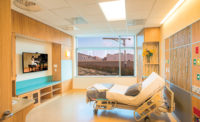Representing a model for future military hospital development, the Clark/McCarthy-led design-build team planned, procured and installed all of the Naval Hospital at Camp Pendleton's medical equipment and furniture, in addition to training hospital staff on how to use the medical devices. This was the first time the Navy had relied on the contracting strategy, which helped the team deliver the $455-million facility $100 million under budget and six months ahead of schedule.
Best Projects judges appreciated the integrated project delivery-type strategy, which they said showed strong results in schedule, spending and safety. "It was a fabulous accomplishment," one judge said.
The procurement method included the selection and delivery of more than 20,000 pieces of hospital equipment, which is typically delivered by multiple subcontractors. The approach encouraged onsite innovations. Best value determination was used for every item, which gave the Navy the opportunity to compare models, options, maintenance contracts and life-cycle costs.
Because the project was funded through the American Recovery and Reinvestment Act of 2009, the team faced a tight time line for completion. "That took traditional approaches off the table, and opened up the team to take a fresh look at the way the project was procured, delivered and overseen," says Dude Underwood, NAVFAC commander. As a result, the Navy selected a design-build method with six phased design packages to identify critical-path activities, such as foundation placement, mass grading and steel framing. Construction of these elements was sequenced weeks earlier than at similar facilities, according to Clark/McCarthy.
All key stakeholders were collocated at the project site, including medical representatives with full decision-making authority, allowing the project participants to "partner closer and more transparently than anybody on the team thought possible before we started," Underwood says. An executive-level group oversaw the project and addressed any issues that couldn't be resolved at the project team level.
The 1-million-sq-ft campus, which replaced an outdated hospital, was built to provide health care to members of the military and their families. The 500,000-sq-ft hospital has 200 procedure rooms and 10 operating rooms. There are also emergency, primary, intensive and specialty care units.
Designed and built to be LEED-Gold certified, the medical complex contains healing gardens, green roofs, expansive atriums, a 170-kW solar photovoltaic power generating system, a 1.2-mile campus walking loop and a 1,500-space parking structure. A central utility plant with 3,100 tons of cooling and redundant utility systems allows the hospital to remain independently fully functional for three days.
The project met all government requirements, and no rework was needed. The contracting team awarded 75% of work to small business-qualified subcontractors.
Judges were also impressed with the project's safety record, which resulted in no lost-time incidents during more than 2.6 million worker-hours.
Using concepts borrowed from NAVFAC's safety program, the Clark/McCarthy team empowered all members of the work force to take corrective action when witnessing unsafe work in the field. "It turned each worker on the site into a safety officer," Underwood says.
In an effort to provide a road map for successful implementation of future government health care projects, NAVFAC compiled more than 500 best practices and lessons learned on the project. Underwood says these have been distributed among NAVFAC staff and other government agencies involved in health care. In addition, a congressional delegation including members from the House subcommittee responsible for Veterans Affairs visited the site to glean information to improve delivery of VA hospital projects, such as the troubled $800-million facility in Aurora, Colo. n
Submitted by Clark/McCarthy, a Joint Venture
Owner NAVFAC
Architects HKS; HDR Architecture
General Contractor Clark/McCarthy, a Joint Venture
Engineers KPFF (structural); Berger ABAM (civil); TMAD Taylor Gaines (mechanical); Exp. (electrical)






Post a comment to this article
Report Abusive Comment